This is the story of building up the Mercian from spring of 2022 to April 2023.
Touching up
First, I removed the headset and bottom bracket that came with the frame and gave it a look over. The headset, interestingly, was a Tange with “Mercian” stamped on the inside. Looking inside the bottom bracket, I could see the pins that were used to hold the tubes for brazing – Mercian are known for their open-hearth brazing method. I hadn’t known Shimano made dropouts, but there we are. The rather stretched seat clamp hole was a known issue.




Then I wiped the frame down with degreaser and washed it with detergent and water. I got a little bottle of touch-up paint from a car parts shop that is a reasonable match. The paint on the top tube cable guides was a bit bashed, & they were a bit rusty inside, so I masked them off & sanded & painted them. And after that, I worked over various other little scratches with the touch-up paint. Going over the touched- up bits with 1200 grade paper and then polishing the whole thing with car wax worked pretty well.




First offerings-up
Shortly after the first batch of parts arrived, I had a first go at partly assembling the bike. The parts in the box at this point included the following:
- New Tecora ‘E’ headset
- New Neco bottom bracket (first attempt: 118 mm, because that was what worked on the Alves with the Specialized cranks)
- NOS Sachs Quarz MTB triple cranks, 170 mm (chainrings 48-44-24, different manufacturers, as available)
- NOS Sachs-Huret plain friction downtube levers, clamp-on (the frame doesn’t have bosses)
- New Dia-Compe Gran Compe 610 centre-pull brakes, with Kool Stop Supra2 brake pads
- Old front brake cable hanger (the original one I’d had on the Alves)
- Old Nitto 6 cm technomic stem
- Old Cinelli Giro d’Italia handlebar (40 cm)
- Old wheels (borrowed from the Alves), IRD Cyclone mark 2 freewheel (7 speed, 13–32)
- Old SunTour XCD 6000 rear and front derailleurs
- Old non-aero Campagnolo Nuovo Record brake levers (chosen partly because it is easy to unhook the brake cables from the levers, and I want the bike to be Rinko-able)
- Old Crank Brothers Candy 2 pedals (borrowed from the Alves)
- New seatpost (no brand)
- It was immediately obvious that the 118 mm bottom bracket spindle was too long – the front derailleur could barely reach the big ring – so I ordered a 110.5 one to replace it. I also had to get curved washers for mounting the brakes, and stainless bolts for them, which I then cut exactly to length, instead of the ones that came with the brakes.
Some metalwork was needed
Further progress required metalwork & I decided I needed a proper workshop setup for it. I finally had time in the summer to build a workbench, & also invested in a work stand for the bike.
Once the workshop existed, I began to apply myself to the trickier issues. The first job was to rescue the seat clamp: the frame has a stamped seat lug instead of a cast one, and the bolt hole was quite badly ovalized. The hole at the top of the seat tube also wasn’t perfectly round. I suspect what might have happened is that the previous owner used a 27.0 mm seatpost by mistake, and then had to tighten the bolt brutally to get it to stick. The Mercian catalogue said the seatpost would be 27.2, and I was able to stuff a bit of 27.2 seatpost offcut in without getting violent. I then worked on fitting a couple of small inserts, made out of 3 mm stainless, into the inside of the seat clamp, so that the rearward force on the bolt would be pushing on the sound metal at the back, rather than on the stretched edge of the hole. After that I made a couple of pieces to fit on the outside of the clamp, to transfer the lateral force of the bolt onto sound metal and to cover up the damage. All of these bits I fixed in place with epoxy, as I’m not equipped for brazing and also didn’t want to start burning off the paint. Finally a bit of tweaking and filing of edges got the opening of the seat tube into a state where it would accept a seatpost fairly smoothly. I polished the outside parts and painted over the rest with the touch-up paint. Not brilliant – the correct repair would be to replace the seat lug – but it’ll do.















Following on the seat clamp, I made a rear brake hanger. I’m not completely happy with this; I didn’t get the bend in the metal right and the whole thing is slightly twisted, but it is quite massive and works. I may revisit this and try to make a more elegant version.
First rideable setup
Having solved these issues, it wasn’t hard to complete the bike up to a state that was rideable. First test ride was on September 6. My first impression was indeed that the shorter reach was giving me a more comfortable position.



To do a more exact comparison, a couple of weeks later I swapped the handlebar and put on the bar and brake levers I’d been using most recently on the Alves:
- Nitto M176 ‘Dream’ handlebar, 42 cm wide
- Dia Compe Evo aero brake levers
At this stage I did an experiment with a Brooks Cambium C15 saddle. Suffice to say it did one 60 km round trip and got taken off again. If I were fitter and more mobile and lighter it might just be that my sit bones would be at home on a slightly narrower saddle than the B17. We’ll store that tiny bit of information away somewhere. So I reverted to my “B17”. About that time, I was having a tiny niggly buzz at the base of my spine (it has phases where it’s a bit iffy for a week or two) and found a position where it went away. Possibly a bit on the low side for times when my spine is happier; but made a mental note of how small the adjustment was to go from “pain” to “no pain”; only 5 mm or so. I had a question mark in my mind about whether I shouldn’t revert to the Flyer version of the saddle, with springs, to be on the safe side. But I thought if I get the fit right, and do my exercises, my back should be happy.
While the tops of the bars now seemed, if anything, closer than they needed to be, I was still finding the hoods a bit of a stretch; at least, my hands were not gravitating to the hoods as the most natural position. Only at this point (!!) did I consider the reach of the handlebars. And as soon as I did so, I realised that the handlebars I’d been using were quite deep from front to back. The Giro d’Italia is officially only 75 mm, but its normal position is with quite a steep downslope on the ramps, so that the hoods are lower/further away. The B135 Randonneur is 105 mm, and the M176 Dream bar is 90 mm. Looking into this, I realized there is such a thing as handlebars that would save 20 mm of reach compared to the M176. So I got a
- Zipp Service Course Ergo 70 mm handlebar, 42 cm wide
This bar has a 31.8 mm clamp. To fit it, I transferred the A-Head adapter I’d been using in my last experiments on the Alves onto the Mercian. I was also thinking about experimenting with the stem length; Tops 1 cm further away but hoods 1 cm closer seemed like an interesting combination. So I also got two Ritchey Comp 4-Axis 6° stems, one 7cm and one 8 cm.
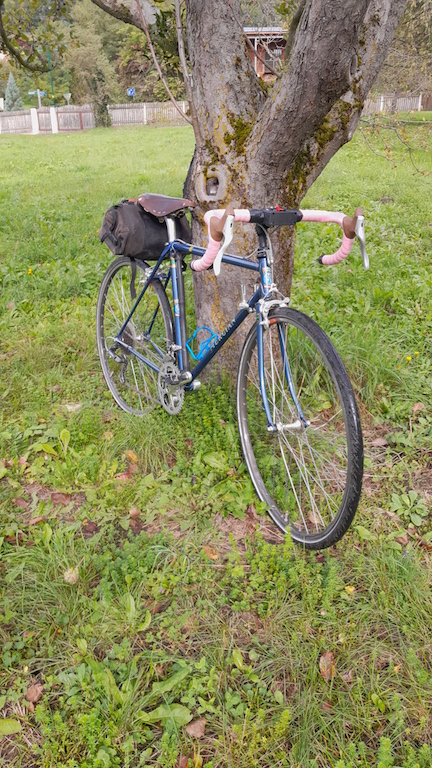
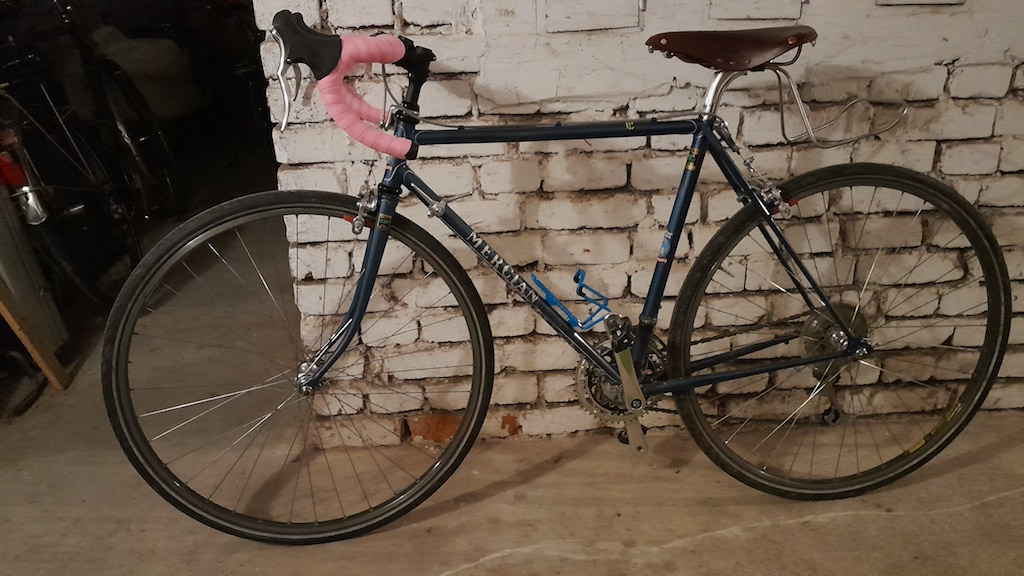
What I was thinking ahead to was the possibility of a Redshift ShockStop stem, which begins at 8 cm and 6°. Turned up, it would have an effective length of just over 7 cm. But before investing almost € 200 in that, I wanted to be sure that that length of stem is fundamentally ok.
Anyway. I rode the bike a bit with the 7 cm stem and the Zipp handlebar, and the fit seemed pretty good. Now it was time to make the bike more practical: I needed mudguards and bags. On one ride I got an absolute soaking in a matter of a few minutes thanks to not having mudguards, and promptly caught a cold. My saddlebag was in danger of rubbing on the tyre. At the front, something I’d been mulling over for years was to set the bag down on a little rack instead of having it on the KlickFix bracket on the handlebars.
March 2023 setup
It took a long time to get around to the next phase of the work, which involved making a lot of fiddly little bits of metal. To cut a long story short, the parts I bought were:
- A Carradice Lowsaddle Longflap saddlebag (c’mon guys, admit it, the real name is “shortarse Longflap”)
- A Carradice Bagman saddlebag support
- A Nitto M18 front rack, with extra long stays
- A pair of Honjo mudguards (H31C hammered, 45 mm wide)
- A Busch & Müller Secula Permanent (AAA batteries) mudguard-mounted rear light.
- A Rixen & Kaul Daypack Box handlebar bag
It took quite a few days in the workshop to get all of these to fit together. Especially the mudguards, but that is mainly because the frame just doesn’t have the tyre clearance. It’s really tight under the front fork. However, it’s done now. I will draw a veil over my efforts splitting the rear mudguard for future Rinko use; it’s complicated and if I could do it again, I’d do it differently.









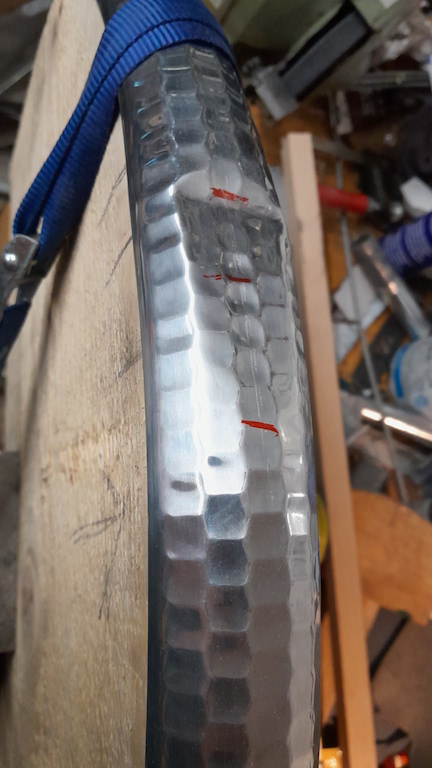






On the front end, I created a bracket that connects the business end of an old KlickFix adapter to a clamp on the stem, so that the “handlebar” bag is not attached to the handlebars. Instead, it rests on the front rack. The clamp is a Salsa post lock seat collar 27.2 mm. A shim made out of a bit of 27.2 mm seatpost reduces it to fit on the 22.2 mm shaft of the stem.
Credit where credit is due, modifying a KlickFix to attach to something that isn’t a handlebar was partly inspired by the Smut Pedaller, though I’ve gone full Klickaleur, so to speak, by attaching it to the stem instead of the rack. I’d seen this post years ago and forgot what bag he was using; turns out I chose the same one. Great minds, eh.





A few further parts were just improvements on the existing ones:
- TRP RRL brake levers have quick-release buttons which make it a lot easier to get the wheels off.
- A NOS Shogun 25.4 mm front brake cable hanger (from mtb-kult.de) is a lot stiffer than the original steel one.
- Time Atac 4 pedals as an alternative to the Crank Brothers ones, whose bearings were not in great shape.
- Swapped the middle chainring for a 38 (48-38-24), abandoning the half-step idea.
- Also tried Mounty Special Power Cages for the bottles. That didn’t turn out so well.


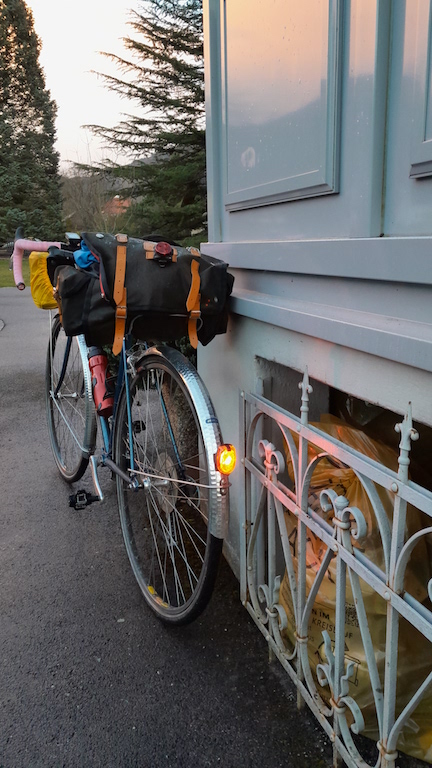
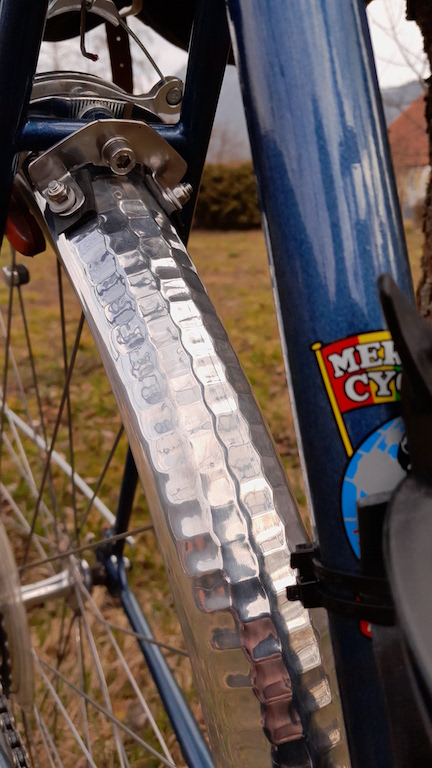

With that I did a bit more riding. Though not without continuing to faff around in an unorganized way.

Leave a Reply
You must be logged in to post a comment.